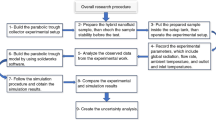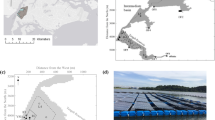Abstract
A solar pond, typical double-diffusive system, is a stable heat source that can collect and store the solar energy. When the thermal stable condition is not satisfied at the interface, the upper and lower convective zone (UCZ and LCZ) will erode the middle non-convective zone (NCZ), resulting in a drop or even a collapse of the thermal performance of solar pond. Wind strongly affects the erosion of NCZ from the entrainment of UCZ. The double-diffusion of heat and salt plays an important role in the erosion of NCZ from the entrainment of the lower-convective zone (LCZ). The turbidity of saline water in the pond not only could lower the thermal performance of solar pond, but have effect on the entrainment mechanism. In this paper, based on the double-diffusive model along with the wind-driven turbulent entrainment model, the effects of turbidity and external wind etc. on the thermal performance of solar pond and the entrainment mechanism are analyzed with the numerical simulation.
Similar content being viewed by others
References
Wang, J. Experiment Studies of Radiation Transmission in Water and Numerical Simulation of Dynamic Behavior of a Salt-gradient Solar Pond: [Doctor Thesis]. USA: Dept. of Mechanical Engineering, Texas A&M University, 1993
Wang,, J, Seyed-Yagoobi, J. Review of Solar Pond Models. In: Proceedings of the Second ASME-JSES-JSME International Solar Energy Conference, Reno, Nevada, 1991. 59–68
Mansour, Ridha Ben, Nguyen, Cong Tam. Nicolas Galanis. Numerical Study of Transient Heat and Mass Transfer and Stability in a Salt-gradient Solar Pond. International Journal of Thermal Sciences, 2004, 43: 779–790
Mansour, A Ben. A Numerical Study of the Transient Behaviors of a Salt-gradient Solar Pond: [Master Thesis]. Canada: Faculty of Engineering, University of Moncton, 2003
Bergman, T L, Incropera, F P, Viskanta, R. A Multi-layer Model for Mixing Layer Development in a Double-diffusive Thermohaline System Heated from Below, International Journal of Heat and Mass Transfer, 1982, 25(5): 883–891
Bergman, T L, Incropera, F P, Viskanta, R. A Differential Model for Salt-stratified Double-diffusive Systems Heated from Below. Solar Energy, 1985, 28(4): 779–788
Hanjalic, K, Musemic, R. Modeling the Dynamics of Double-diffusive Scalar Fields at Various Stability Conditions. Int. J. Heat and Fluid Flow, 1997, 18: 360–367
Atkinson, J F, Harleman, D R F. A Wind-mixing Layer Model for Solar Ponds. Solar Energy, 1988, 38: 243–259
McMinn, S L. Effect of Wind Speed on the Growth of the Upper Convective Zone in a Solar Pond: [Master Thesis]. USA: Dept. of Mechanical Engineering, Texas A&M University, 1990
Meyer, K A. A Numerical Model to Describe the Layer Behavior in Salt-Gradient Solar Ponds. Journal of Solar Energy Engineering, 1983, 105: 341–347
Poplawsky, C J, Incropera, F P, Viskanta, R. Mixed Layer Development in a Double-diffusive Thermohaline System. Solar Energy, 1981, 103: 351–359
Bergman, T L, Incropera, F P, Viskanta, R. The Behavior of a Salt-stratified, Double-diffusive, Thermohaline Solution Heated from Below. Journal of Heat Transfer, 1981, 24(5): 763–769
Kishore, V V N, Joshi, Veena. A Practical Collector Efficiency Equation for Nonconvective Solar Ponds. Solar Energy, 1984, 33(5): 391–395
Huppert, H E. On the Stability of a Series of Double-diffusive Layers. Deep Sea Research, 1971, 18: 1005–1021
Schirtcliffe, T G L. Transport and profile Measurement of the Diffusive Interface in Double-diffusive Convection with Smaller Diffusivities. Journal of Fluid Mechanics, 1973, 57: 27–43
Weinberger, H. The Physics of the Solar Pond. Solar Energy, 1964, 8: 45–56
Zangrando, F. On the Hydrodynamics of Salt-gradient Solar Ponds. Solar Energy. 1991, 46: 323–248
Zhao, Jian-hua, Sun, Wen-ce, Xie Mao-zhao, et al. A Two-dimensional Mathematical Model of Seawater Solar Pond. Journal of Dalian University of Technology, 2004, 45(1): 32–35
Author information
Authors and Affiliations
Rights and permissions
About this article
Cite this article
Xie, M., Ge, S. & Sun, W. Numerical simulation of double-diffusive dynamical model of a solar pond considering the effect of turbidity and wind. J. of Therm. Sci. 15, 168–174 (2006). https://doi.org/10.1007/s11630-006-0168-6
Received:
Issue Date:
DOI: https://doi.org/10.1007/s11630-006-0168-6




